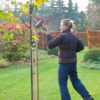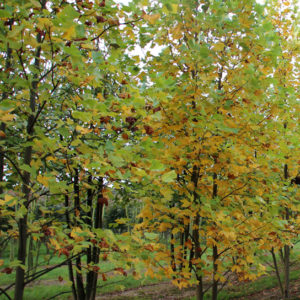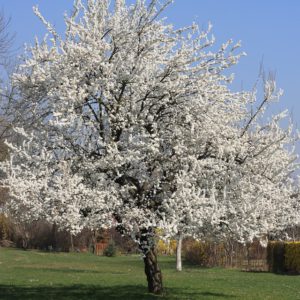Acer campestre / Field Maple
Price range: €450.00 through €700.00
Frequently Bought Together



Description
Common Name: Field Maple, Hedge Maple, Common Maple
Botanical Name: Acer campestre
Family: Sapindaceae
Origin: Native to Europe including Britain and Ireland
Mature Height: 10-15 metres (can be kept smaller with pruning)
Mature Spread: 8-10 metres
Growth Rate: Moderate (30-40cm per year)
Foliage: Deciduous; five-lobed leaves, fresh green in spring and summer, turning spectacular shades of butter-yellow to golden-orange in autumn
Flowers: Small, greenish-yellow clusters in April-May; inconspicuous but attractive to pollinators
Fruit: Winged seeds (samaras) in autumn, held horizontally in pairs
Soil Requirements: Highly adaptable; thrives in clay, loam, chalk, or sandy soils; tolerates alkaline conditions; prefers well-drained to moist soil
Light Requirements: Full sun to partial shade
Hardiness: Fully hardy (USDA Zone 5-8); tolerates exposed sites and urban pollution
Special Features: Outstanding autumn colour; excellent for hedging; native species with high wildlife value; tolerates hard pruning; drought-tolerant once established
Description
The Field Maple is Britain and Ireland’s only native maple – a tree that has woven itself into the fabric of our hedgerows and woodlands for thousands of years. Compact and well-mannered, it brings the grace of the maple family to gardens where larger species would overwhelm, making it perfect for smaller plots, mixed borders, or as a specimen tree in more intimate settings.
In spring, the Field Maple unfurls fresh green leaves alongside clusters of tiny greenish-yellow flowers that hum with pollinating insects. Through summer, its rounded canopy provides dappled shade and a calm, verdant presence. But it’s in autumn that Acer campestre truly shines – the foliage transforms into a spectacular display of butter-yellows, golds, and warm oranges that glow in the low autumn light.
The bark of mature specimens develops attractive corky ridges, adding winter interest and textural contrast to the garden. Its winged seeds, held in horizontal pairs like tiny helicopters, provide food for birds and small mammals whilst adding decorative detail through autumn and winter.
What makes the Field Maple particularly valuable is its versatility. It can be grown as a multi-stemmed specimen, trained as a standard tree, or clipped into formal hedging. It tolerates hard pruning without complaint, responds well to pleaching, and thrives in urban conditions where pollution and compacted soil challenge lesser trees.
For wildlife, the Field Maple is a quiet hero. Its flowers feed early pollinators, its leaves support numerous moth caterpillars, and its seeds provide autumn and winter food for birds. The dense canopy offers nesting sites, whilst the textured bark harbours invertebrates that feed larger creatures.
This is a tree for those who value native character, seasonal beauty, and ecological generosity – a true British and Irish classic that earns its place in any thoughtful planting scheme.
Caragh Garden Notebook: Caring for Your Acer campestre
Planting Your Field Maple
Choose a site in full sun or partial shade with reasonably well-drained soil. The Field Maple is remarkably adaptable and will thrive in clay, chalk, loam, or sandy conditions. It tolerates alkaline soils particularly well, making it ideal for lime-rich gardens.
Dig a planting hole twice the width of the root ball but no deeper. Position the tree so the top of the root ball sits level with the surrounding soil. Backfill with excavated soil, firm gently to eliminate air pockets, and water thoroughly. Apply a 5-7cm layer of organic mulch around the base, keeping it clear of the trunk.
Plant bare-root or root-balled specimens from November to March, or container-grown trees year-round (though autumn and spring establishment is preferable).
Watering & Feeding
Water regularly during the first two growing seasons to establish a deep, drought-tolerant root system. Once established, the Field Maple requires minimal supplemental watering except during prolonged drought.
Apply a balanced slow-release fertiliser in early spring for the first few years. Mature specimens require no feeding – simply maintain the mulch layer to conserve moisture and suppress weeds.
Pruning & Maintenance
The Field Maple requires minimal pruning when grown as a specimen tree. Remove any dead, damaged, or crossing branches in late autumn or winter (November-February) when the tree is fully dormant.
For hedging, trim once or twice annually – a light trim in midsummer (July) and a harder cut in late winter (February) will maintain dense, formal growth. The Field Maple responds exceptionally well to clipping and can be shaped into architectural forms.
If training as a standard, remove lower branches gradually over the first 3-5 years to achieve the desired clear stem height.
Seasonal Interest
Winter: Attractive corky bark on mature specimens; architectural branch structure; persistent winged seeds add delicate detail.
Spring: Fresh green leaves unfurl; clusters of greenish-yellow flowers attract early pollinators in April-May.
Summer: Rounded canopy of calm green foliage provides cooling shade; winged seed pairs begin to develop.
Autumn: Spectacular transformation to butter-yellow, gold, and warm orange; seeds ripen and provide food for wildlife.
Companion Planting
The Field Maple’s native character pairs beautifully with other British and Irish natives. Underplant with Primula vulgaris (Primrose), Hyacinthoides non-scripta (Bluebell), Anemone nemorosa (Wood Anemone), or Geranium robertianum (Herb Robert) for a woodland-edge effect.
For mixed hedging, combine with Crataegus monogyna (Hawthorn), Corylus avellana (Hazel), Prunus spinosa (Blackthorn), and Ilex aquifolium (Holly) to create ecologically rich boundaries.
In ornamental borders, the Field Maple’s autumn colour complements late-season perennials such as Aster, Sedum, and ornamental grasses.
Pests & Diseases
Generally healthy and trouble-free. Occasionally affected by aphids in spring (usually not requiring treatment) or tar spot fungus (cosmetic only, does not harm the tree). Good air circulation and avoiding overhead watering help prevent fungal issues.
Why Choose Acer campestre from Caragh Nurseries?
Our Field Maples are grown with care to ensure strong root systems and healthy, well-structured specimens. Whether you’re creating a native hedge, seeking spectacular autumn colour, or need a compact tree for a smaller garden, Acer campestre offers beauty, adaptability, and ecological value in equal measure. This is a tree that truly belongs – in our landscape, in our gardens, and in our hearts.





